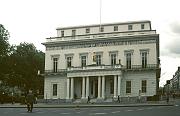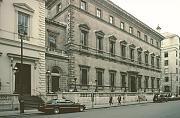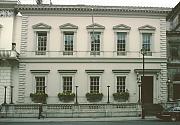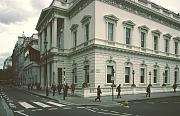 Pall Mall with from left to right: United Services Club, Athenaeum, Traveller's Club, Reform Club
Pall Mall with from left to right: United Services Club, Athenaeum, Traveller's Club, Reform Club
NINETEENTH CENTURY GENTLEMAN'S CLUBS
Introduction
Although the clubs were enormously popular with upper-class London males in the nineteenth century, they had actually originated much earlier, some believe with White's, which began as a chocolate house in 1693 and had such famous members as Pope, Swift, Steele, and Gray. Coffee houses in the eighteenth century also housed gatherings of male customers, gatherings which became more formalized in club membership eventually with permanent quarters on Pall Mall and St. James Street, close to Whitehall and the royal palaces.
The nineteenth century was the age of clubs, each with its own building resembling a stately mansion where gentlemen smoked, drank, ate, read (in libraries or news rooms), gambled, played billiards, and socialized among their peers. Members were elected (or not--that is, blackballed) and clubs members often had common political or recreational interests. Among the political clubs in the Victorian period were the Reform Club, an institution of the Liberals with a name relating to the famous Reform Act of 1832, the Conservative, and the Carlton founded by the Duke of Wellington in 1832. Others clubs were for members of the universities (The Oxford and Cambridge University Clubs), for automobile fanciers (The Royal Automobile Club), for mountaineers, for members of the Army and Navy (The Army and Navy Club), for travellers who had been more than 500 miles from London (The Traveller's Club), and for artists, writers, and scientists and their patrons (Athenaeum Club). It was not uncommon for a gentleman to have membership in more than one club. Women were of course not admitted, although by the end of the nineteenth century there were some clubs for women. Waiting lists were long, even for males.
These large clubs were most often designed in the classical style, even though much Victorian architecture was inspired by Gothic precedents. Most had a number of large rooms: library, lounge, dining room, smoking room, billiard room, and card room. In the second half of the century some provided bedrooms for members who lived outside the city and preferred to stay in the club rather than a commercial hotel. Many had outstanding libraries. The clubs were generally furnished in an austere "bachelor" style, foregoing the "feminine" clutter of the typical Victorian house.
The clubs still exist but some are no longer male bastions, for the Athenaeum Club in 2002 voted to admit women. However, the Carlton Club, with members in the Conservative Party, still excludes women from full membership, with former Prime Minister Margaret Thatcher being the sole full member. In some clubs women are only allowed associate memberships and are excluded from some privileges--use of the bar and library, for example.
Index of Clubs on this Site
 Click here to return to index of art historical sites.
Click here to return to index of art historical sites.
 Click here to return to index of artists and architects.
Click here to return to index of artists and architects.
 Click here to return to chronological index.
Click here to return to chronological index.
 Click here to see the home page of Bluffton College.
Click here to see the home page of Bluffton College.
© 2003 Mary Ann Sullivan.
I have photographed (on site), scanned, and manipulated all the images on these pages. Please feel free to use them for personal or educational purposes. They are not available for commercial purposes.






 Click here to return to index of art historical sites.
Click here to return to index of art historical sites.
 Click here to return to index of artists and architects.
Click here to return to index of artists and architects.
 Click here to return to chronological index.
Click here to return to chronological index.
 Click here to see the home page of Bluffton College.
Click here to see the home page of Bluffton College.
